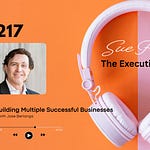Released September 4, 2025 | Episode 216 Episode Summary
In this episode of The Executive Edge, host Sue Firth sits down with leadership and strategic change advisor Dan Roberts to explore the critical human element of organizational transformation. Drawing from extensive experience in change management and organizational development, Dan shares practical strategies for helping companies navigate change successfully while maintaining team engagement and momentum.
Guest Bio
Dan Roberts is a leadership and strategic change advisor with a background in behavioral psychology and business. His career has focused on helping companies achieve genuine growth through effective change management. Dan is the founder of Impactful Performance and author of "Optimize Your Leadership: An Impactful and Healthy Way to Lead in the New Age."
Key Takeaways The Foundation of Successful Change
Change management is fundamentally about the people side of change, not just technology and processes
Companies often know what they want to achieve but struggle with how to get there
Success requires asking the right questions rather than having all the answers
The "Slow Down to Speed Up" Principle
Organizations need to be intentional and strategic about change implementation
Creating a structured plan and process optimizes conditions for success
Avoiding the rush to implement prevents setting up for failure
Essential Elements of Change Management
Clear Communication: Explain the "why" behind changes, not just the "what"
Resource Assessment: Ensure people, processes, and technology are in place
Risk Management: Identify barriers and resistance points early
Roadmap Creation: Develop step-by-step plans people can understand
Training & Support: Provide adequate preparation and ongoing assistance
Making Change Less Scary
Connect changes to existing pain points that employees recognize
Frame changes to show "what's in it for them" (WIIFM)
Use peer-to-peer champions rather than top-down mandates
Introduce changes in digestible, bite-sized chunks
Pilot programs can help problem-solve before full rollout
Leadership in Uncertain Times
Focus on what you can control vs. the macro environment
Create a calm, even-keeled leadership presence amid chaos
Use the "win the day" approach: plan the work, work the plan
Think in project-based cycles rather than rigid long-term plans
Maintain focus on immediate, actionable steps while keeping the vision clear
The Power of Language
How you phrase messages determines how they're received
Use softer language (e.g., "fluid" instead of "volatile")
Ensure consistent messaging across all leadership
Balance transparency with avoiding unnecessary alarm
Memorable Quotes
"It's not about having the answers. It's are we asking the right questions?"
"You have to slow down to speed up"
"Plan the work, work the plan, don't plan the results"
"Looking too far in the future is anxiety, and looking in the past is depression"
Action Items for Leaders
Conduct strategic planning sessions focused on your unit's value to the organization
Develop clear, consistent talking points for all leaders to use
Identify and empower peer champions within teams
Break large changes into manageable monthly and quarterly goals
Focus on "winning the day" rather than obsessing over long-term outcomes
Resources Mentioned
Website: impactfulperformance.com
Book: "Optimize Your Leadership: An Impactful and Healthy Way to Lead in the New Age" (available on Amazon)
LinkedIn: Dan Roberts
Final Thoughts
Change is inevitable in today's business environment, but with the right approach focused on people, clear communication, and manageable implementation, organizations can navigate transformation successfully. The key is remembering that while you can't control the macro environment, you can control how your team responds to and moves through change.
The Executive Edge with Sue Firth provides practical skills for success in life and business. Subscribe on all major podcast platforms for more insights from leading experts.






